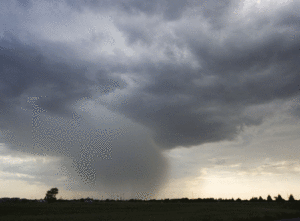What’s a Microburst?
Microbursts are violent, small-scale downdrafts of air that form over land, particularly during thunderstorms. They may occur on their own or in conjunction with a squall line, which can lead to severe damage and injury if they move through your area. What causes microbursts?
 Understanding microbursts
Understanding microbursts
A microburst is a sudden, intense downdraft that can cause extensive damage. These small-scale storms are produced by thunderstorms and can last anywhere from a few seconds to several minutes. Microbursts can occur with both wet and dry conditions, but dry microbursts are more common and tend to be more destructive. When a dry microburst moves through an area, it can quickly cause severe wind damage. In some cases, wind speeds can exceed 100 mph! The National Weather Service has developed the Fujita Scale which categorizes tornadoes based on their intensity and impacts. It ranges from F0 (weakest) to F5 (strongest). Dry microbursts have been classified as EF2 on the Fujita Scale because of their high winds.
Causes of microbursts
It all starts when a thunderstorm forms and the water droplets and hailstones are suspended in the updraft. Sometimes an updraft can be so strong that it suspends large quantities of these droplets and hailstones near the top of the storm. Several factors can lead to evaporational cooling (sinking air) and weaken the updraft. If this happens, the storm will be unable to hold the large core of rain or hail. The core plummets to the ground, spreading out in all directions as it hits the ground. When the microburst hits the ground, it causes the most damage and the strongest winds.
Forecasting microbursts
Microbursts are most commonly associated with thunderstorms, and can occur when the storm’s updraft can no longer support the weight of the water falling from the clouds. If a thunderstorm is forecasted, a microburst can occur. There have been incidents where buildings were damaged or even destroyed by a microburst. Microbursts have also been known to cause fatalities due to airborne debris. They are sometimes mistaken for tornadoes because they appear as rotating columns of air. The difference between a tornado and a microburst is that a tornado will be in contact with the ground while there’s no ground contact with microbursts. For example, if you look out your window and see trees blowing one way, then you know that you’re dealing with wind coming from one direction.
Damage caused by microbursts
These downdrafts are incredibly powerful and can cause extensive damage. In fact, microbursts can generate wind speeds of up to 100 mph! This can easily damage roofs, windows, and trees. Plus, the sudden downdraft can create a mini-tornado effect, which can lift and toss cars and other objects. In addition, these downdrafts will typically go for about 20 miles before dissipating; this is why people living in areas with frequent downpours need to be aware of this phenomenon.
Damage caused by a microburst can be extensive and can absolutely lead to loss of life.
How To Prepare For A Microburst
If you’re outdoors during a storm, try to get indoors quickly if you see dark clouds or feel rain turning into small hail pellets or heavy rain that suddenly starts falling faster than usual. If you don’t have anywhere safe to go inside, stay away from power lines and unsecured objects outside that could become airborne when the downdraft hits.
If you’re driving when you encounter a microburst, it’s best to stay calm and not try to outrun it. Instead, make sure your vehicle is pulled over as far away from any large trees or power lines as possible. Be sure to also buckle your seatbelt and cover your head with a blanket or jacket if possible.
If you live in an area where microbursts are common, it might be worth investing in some inexpensive weather radios that alert people to these dangers. For example, the NWS Weather Radio All Hazards (NWR) offers forecasts and warnings with severe weather alerts. These devices will sound an alarm and provide specific instructions during a tornado or other extreme weather event. They are easy to use and don’t require subscriptions or downloads – just plug them into any power outlet in your home or office, turn them on, and they’re ready to go!
Preventing injuries from microbursts
To help prevent injuries from microbursts, it’s important to be aware of the warning signs and to take shelter immediately when one is occurring. It’s also important to have a plan in place for what to do if a microburst does occur. By being prepared, you can help keep yourself and others safe from harm. Make sure that your family has a disaster plan in place. The National Weather Service provides excellent resources on how to create a plan that works for your family’s needs.
When To Act Fast Against A Microburst
Stay indoors or get into your car as quickly as possible and drive away from the wind. If there is no shelter nearby, lie down with your head facing down (beneath debris) to minimize injury from flying objects.
-If you cannot escape immediately, cover your head with anything available (even your hands). If the storm has passed, seek shelter as soon as possible.
When outdoors, stay clear of downed power lines and trees. It’s also important to remember that the effects of a microburst may not be visible until after the storm passes- fallen trees may block roads, for example.
Finally, follow instructions given by emergency personnel- don’t venture out unnecessarily when it could put you in danger.









